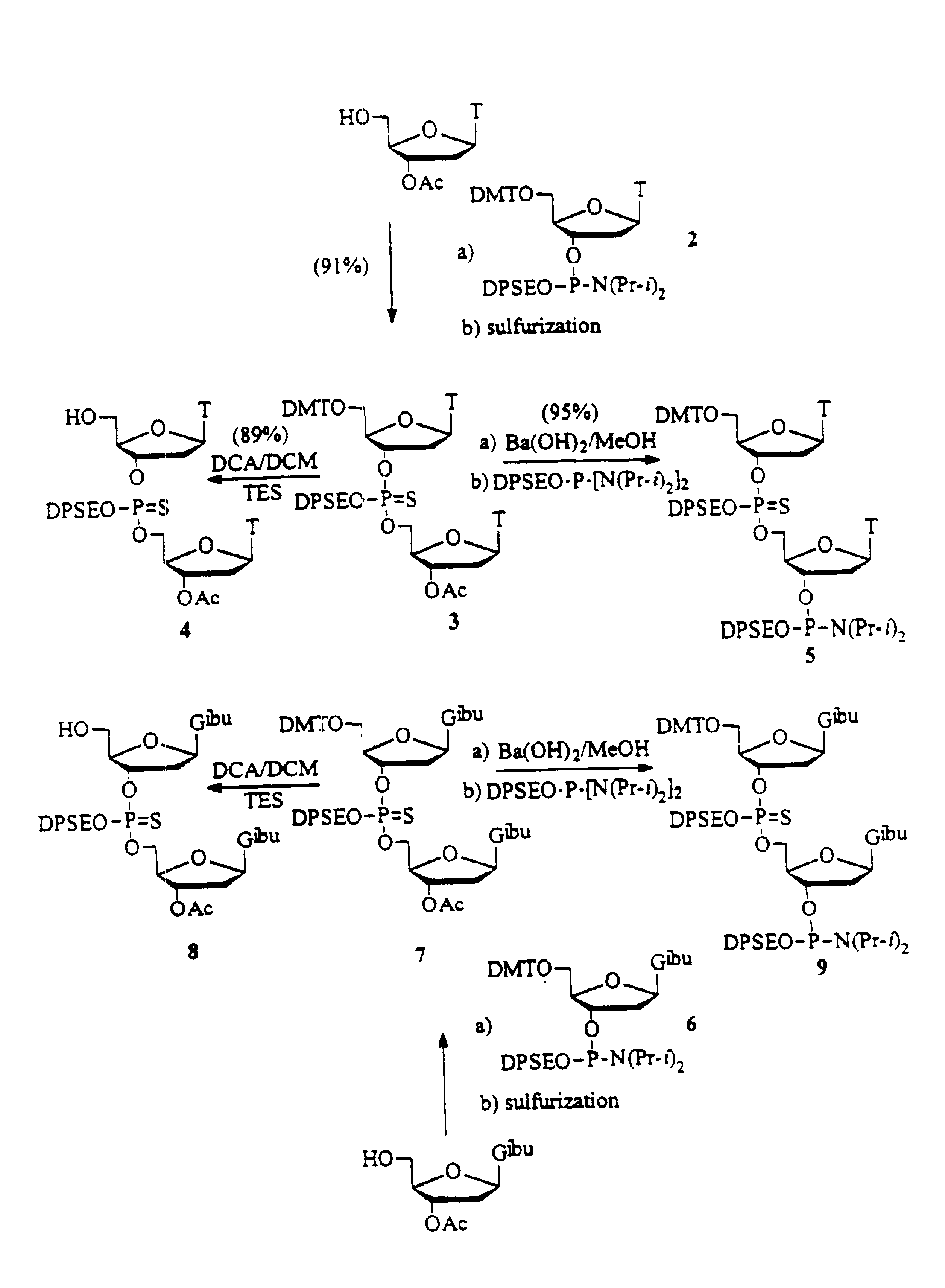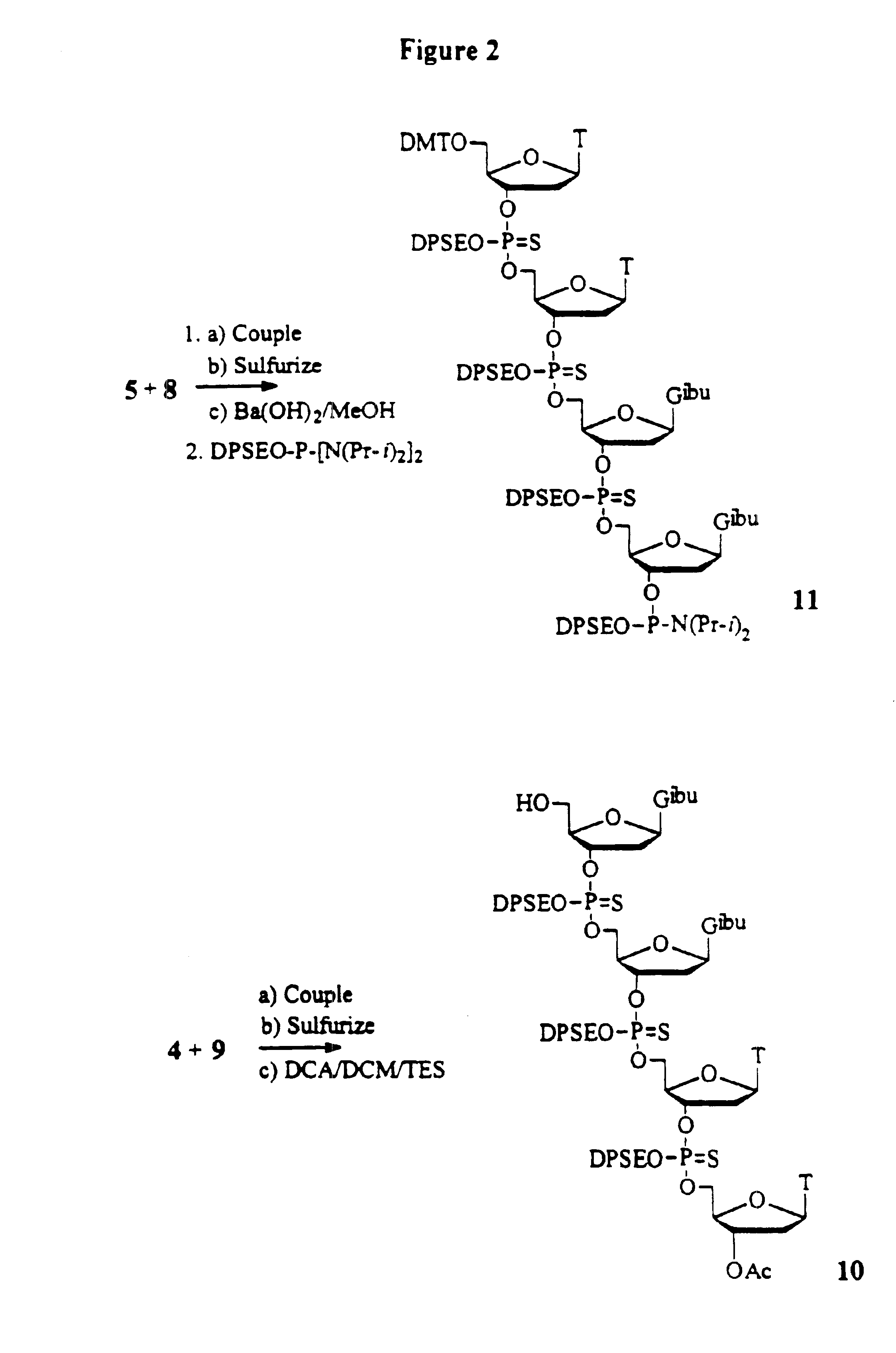Synthesis of oligonucleotides
a technology of oligonucleotide and synthesis process, which is applied in the field of synthesizing oligonucleotides, can solve the problems of not being exposed to aggressive mixing, not being able to withstand aggressive mixing, and the number of individual strands that can be anchored to a unit surface area of the support is limited, so as to facilitate the synthesis and identification of useful oligonucleotides
- Summary
- Abstract
- Description
- Claims
- Application Information
AI Technical Summary
Benefits of technology
Problems solved by technology
Method used
Image
Examples
example 1
Preparation of Fully Protected TT Dimer:
To a solution of 1.42 g (5.0 mmol) of 3′-acetyl thymidine and 0.35 g (4.0 mmol) of 1-H Tetrazole in acetonitrile (60 mL) is added 5.50 / g (6.0 mmol) of 5′-O-(4,4′-dimethoxytrityl) thymidine-3′-O-(2-diphenylmethylsilylethyl N,N-diisopropylphosphoramidite in 40 mL acetonitrile. The reaction mixture is stirred at room temperature under argon for 0.5 h. A solution of 5.0 g (25 mmol) of 3H-1,2-benzodithiol-3-one 1,1-dioxide in acetonitrile is added as quickly as possible with vigorous stirring. The reaction mixture is stirred at room temperature for 20 minutes. The reaction mixture is then filtered and concentrated. The crude product is purified by flash chromatography on silica gel using ethyl acetate / hexane. 1% triethylamine is used during the purification. 31P-NMR (CDCl3, ppm): 66.80, 67.07.
example 2
Preparation of Fully Protected GG Dimer:
To a solution of 3′-acetyl-N2-isobutyryl-2′-deoxyguanosine (5.0 mmole) and 1-H Tetrazole (4.0 mmole) in acetonitrile (60 mL) is added 5.50 g (6.0 mmol) of N2-Iso-butyryl-5′-O-(4,4′-dimethoxytrityl)-2′-deoxyguanosine-3′-O-(2-diphenylmethylsilylethyl N,N-diisopropylphosphoramidite) in acetonitrile (40 mL). The reaction mixture is stirred at room temperature under argon for 0.5 h. A solution of 5.0 g (25 mmole) of 3H-1,2-benzodithiol-3-one 1,1-dioxide in acetonitrile is added as quickly as possible with vigorous stirring. The reaction mixture is stirred at room temperature for 20 minutes. The reaction mixture is then filtered and concentrated. The crude product is purified by flash chromatography on silica gel using ethyl acetate / hexane. 1% Triethylamine is used during the purification. 31P-NMR (CDCl3, ppm): 66.8, 67.1.
example 3
Preparation of the 5′-HO-TT Dimer:
Fully protected phosphorothioate TT dimer (1 mmol) is dissolved in dichloromethane (50 mL) and 3% dichloroacetic acid in dichloromethane (v / v) (20 mL) is added and stirred for 15 minutes. The reaction mixture is concentrated and purified by flash chromatography on silica gel using ethyl acetate / hexane. 1% Triethylamine is used during the purification. 31P-NMR (CDCl3, ppm): 67.3, 67.41.
PUM
 Login to View More
Login to View More Abstract
Description
Claims
Application Information
 Login to View More
Login to View More - R&D
- Intellectual Property
- Life Sciences
- Materials
- Tech Scout
- Unparalleled Data Quality
- Higher Quality Content
- 60% Fewer Hallucinations
Browse by: Latest US Patents, China's latest patents, Technical Efficacy Thesaurus, Application Domain, Technology Topic, Popular Technical Reports.
© 2025 PatSnap. All rights reserved.Legal|Privacy policy|Modern Slavery Act Transparency Statement|Sitemap|About US| Contact US: help@patsnap.com



